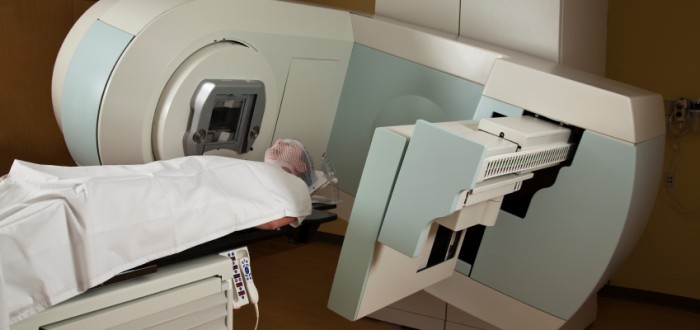Dramatically improved mesothelioma survival rates appear to have been achieved by researchers at Canada’s Princess Margaret Cancer Centre after using a novel radiation therapy protocol. It was designed to reduce the recurrence of mesothelioma cells following extrapleural pneumonectomy (EPP) surgery.
The researchers’ findings appeared in the Jan. 20 online edition of the Journal of Thoracic Oncology and pointed to a 125 percent increase in survival among mesothelioma patients who underwent EPP.
“The three-year survival rate more than doubled to 72 from 32 percent compared to our previous treatment protocol,” said University of Toronto assistant professor John Cho, M.D., a radiation oncologist with Princess Margaret Cancer Centre and the lead investigator of the research team responsible for the therapy breakthrough.
MesotheliomaClinic.org has learned privately from Cho that the new protocol involves treating patients with radiation first and then afterward performing EPP surgery. The conventional approach does it the other way around — radiation last. It also packs five week’s worth of radiation therapy into a single week, Cho revealed.
“The problem with giving radiation first is that the dose necessary to sterilize the cancer cells or at least render them incapable of reproducing to normal cells exceeds what’s safe for that lung,” he offered. “If the EPP surgery won’t be done for another couple of months after that, the patient will develop severe radiation pneumonitis in the treated lung and soon afterward die from respiratory failure.”
Cho explained that the new protocol solves this problem by requiring removal of the treated lung no later than 10 to 14 days after completion of the radiation therapy. “In that short time, radiation pneumonitis does not have a chance to set in,” he said.
Who the EPP Radiation Therapy Protocol Can Help
Contained within the thoracic cavity are two lungs. Mesothelioma usually begins on the lining of only one of those lungs. In an EPP surgery, the entire affected lung and its lining are permanently removed. Also usually taken out are the hemidiaphragm and the lining of the heart.
Cho was quick to point out that the new EPP radiation therapy protocol can be used “only if the patient’s disease is at a stage where it’s still possible to perform the surgery. I can only give the radiation if the surgeon can operate.”
Generally, this limits the protocol to patients in mesothelioma stages I and II, although Cho said stage III patients may be candidates provided the surgeon believes the lung is removable.
“Also, if the disease is still resectable, then the patient is likely fit enough to tolerate the radiation,” he added.
Those who should see the best results from radiation before EPP are patients with the epitheliod type of mesothelioma, Cho observed. “Biphasic and sarcomatoid mesothelioma patients don’t gain much from this protocol, but there are exceptions,” he said.
Others who probably will not benefit include those with bulky, significantly involved mediastinal nodes, Cho conceded.
Why Mesothelioma Recurrence is Often High After EPP
The new protocol goes by the name SMART — Surgery for Mesothelioma After Radiation Therapy.
Cho and his colleagues came up with the protocol after brainstorming for answers to the nagging question of why mesothelioma recurs at such high rates following EPP surgery.
“EPP performed without benefit of chemotherapy or postoperative radiation typically sees local recurrence rates of up to 80 percent,” he said.
One idea the research team homed in on held that the entire thoracic cavity becomes contaminated with mesothelioma cells during surgery.
“Perhaps removing the lung and other structures during surgery opens a channel between the affected lung and the unaffected parts of the thoracic cavity,” Cho said they speculated. “This open channel then permits inadvertent spillage of tumor cells into these other areas. So even if you remove the lung and the lining, it’s likely that microscopic cells are still inside — and that presumably is what causes recurrence.”
This hypothesis, said Cho, gave rise to the notion that delivering radiation therapy before surgery could improve EPP outcomes by reducing the number of cancer cells available to spill over into tumor-free areas. This is a strategy akin to subjecting a beachhead to days of naval shelling and aerial bombardment ahead of the landing of ground troops.
SMART Radiation Therapy Involves a Trade-Off
Effective though SMART appears to be, it does have a drawback. According to Cho, it significantly extends the time it takes to recover from EPP surgery.
“In our previous experience with trimodality chemotherapy-surgery-radiation, patients would be fatigued and take maybe one or two months to recover,” he said. “But with this new regimen, patients dip down deeper and longer in terms of fatigue. Recovery can take six to 12 months.”
The trade-off, of course, is that patients tend to live a lot longer.
The SMART study lasted more than four years and involved 25 patients treated at Princess Margaret Cancer Centre and surgery at Toronto General Hospital (the two institutions belong to University Health Network).
Since the study completed, an additional 20 mesothelioma patients have been successfully treated using the SMART protocol, Cho reported.
“A next step is to see if our results can be replicated in other centers,” he told MesotheliomaClinic.org. “Once we get a bit more experience, my hope is to try to conduct a multicenter clinical trial.”
Cho said he believes the SMART protocol can become a standard of care throughout Canada as well as the United States. However, “EPP itself as a treatment for mesothelioma is still quite controversial, depending on who you ask,” he cautioned. “Because it remains controversial, there will likely be a number of hurdles to overcome before the SMART procedure is widely adopted.”


